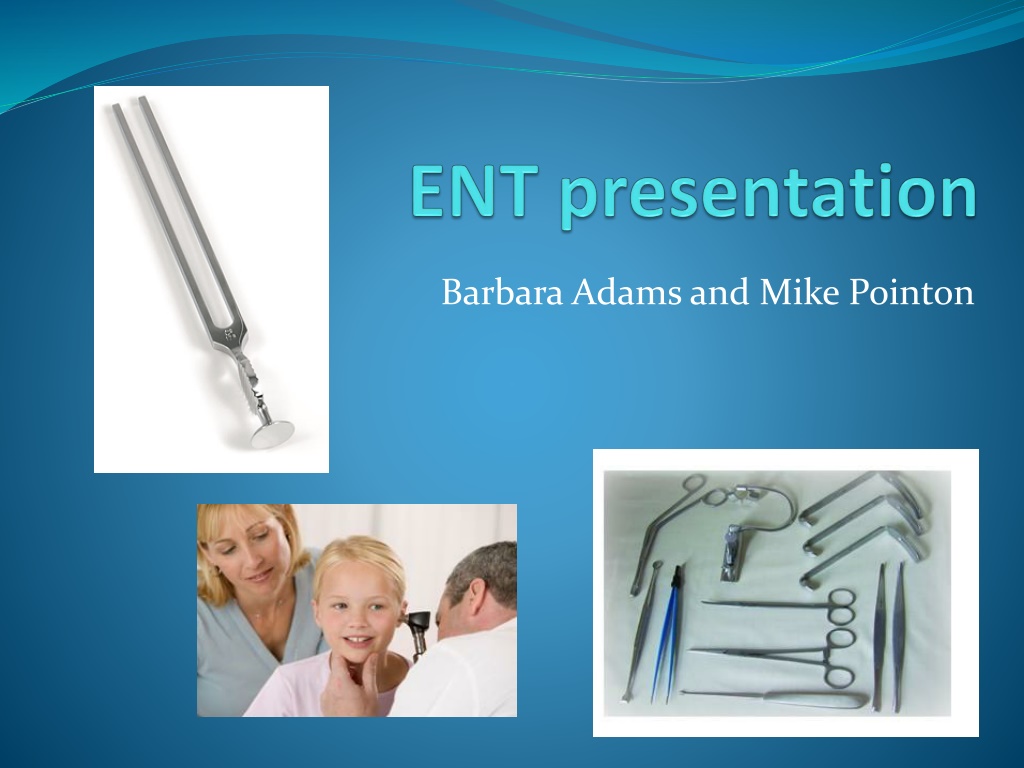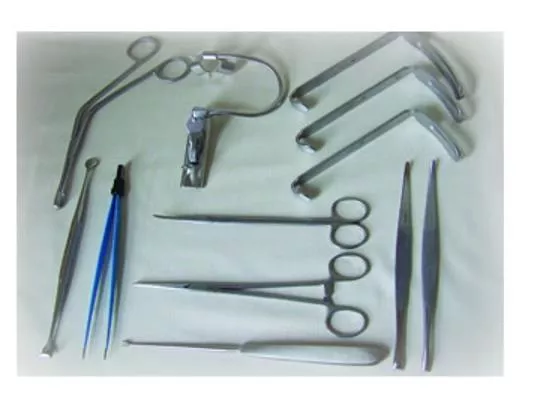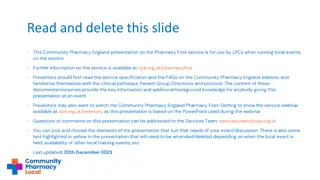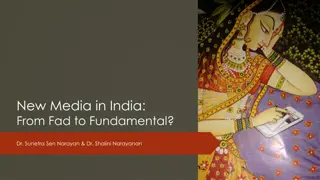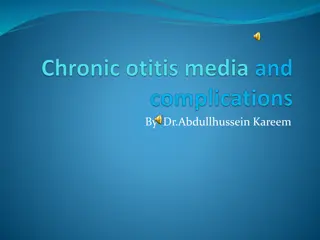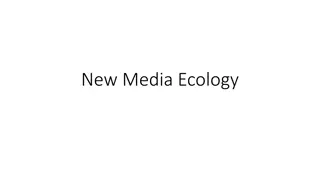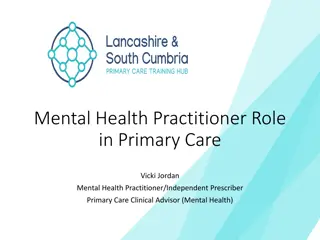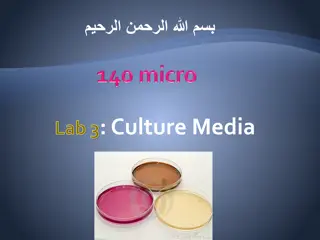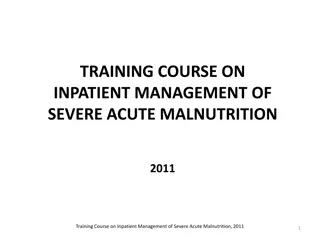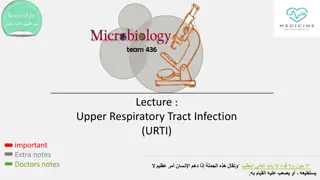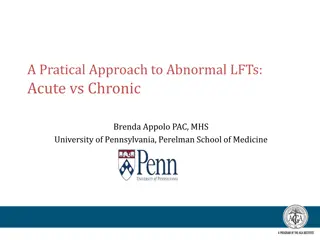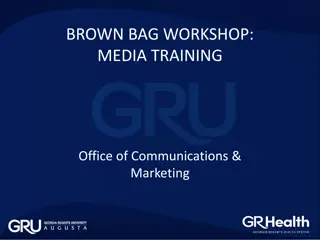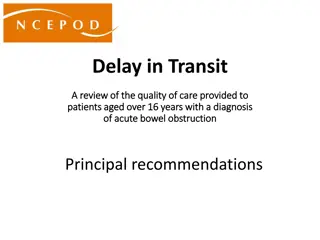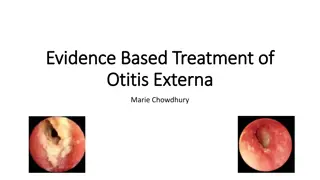Acute Otitis Media in Primary Care
Learn about assessing and managing common ENT problems in primary care, watchful waiting, and referral guidelines. Explore the definitions, causes, complications, and diagnosis of Acute Otitis Media (AOM) along with its differential diagnoses and management strategies. Enhance your knowledge in recognizing AOM symptoms, differentiating from other URTIs, and understanding potential complications like mastoiditis.
Download Presentation

Please find below an Image/Link to download the presentation.
The content on the website is provided AS IS for your information and personal use only. It may not be sold, licensed, or shared on other websites without obtaining consent from the author.If you encounter any issues during the download, it is possible that the publisher has removed the file from their server.
You are allowed to download the files provided on this website for personal or commercial use, subject to the condition that they are used lawfully. All files are the property of their respective owners.
The content on the website is provided AS IS for your information and personal use only. It may not be sold, licensed, or shared on other websites without obtaining consent from the author.
E N D
Presentation Transcript
Aims and objectives Know how to assess and manage common ENT problems in primary care Know about watchful waiting and use of delayed prescriptions Know how and when to refer to ENT secondary care for non-urgent referrals Know about ENT emergencies and how to refer
Acute otitis media (AOM) definitions AOM: Infection in middle ear, characterised by presence of middle ear effusion associated with acute onset of signs and symptoms of middle ear inflammation Recurrent AOM: 3 episodes in 6m or 4 in 1y with absence of middle ear disease between episodes Persistent AOM (treatment failure): symptoms persist after initial management (no antibiotics, delayed antibiotics or immediate antibiotic prescribing strategy) or symptoms worsening
AOM: causes & complications Bacterial infection: most common- strep pneumoniae, h influenzae (only 10% due to type B and preventable by HIB vaccine), moraxella catarrhalis Viral infection: most common- respiratory syncytial virus and rhinovirus Complications: hearing loss; chronic perforation and otorrhoea, CSOM, cholesteatoma, intracranial complications
Mastoiditis AOM: diagnosis Presents with earache (!) In younger children-non specific symptoms, e.g rubbing ear, fever, irritability, crying, poor feeding, restlessness at night, cough, or rhinorrhoea AOM AOM
AOM Differential diagnoses Other URTI: may be mild redness of TM, self limiting Otitis media with effusion (OME)/ glue ear: fluid in middle ear without signs of acute inflammation of TM CSOM: persistent inflammation and TM perforation with exudate >2-6w. May lead to . . . . . . Acute mastoiditis (rare)- swelling, tenderness and redness over mastoid bone, pinna pushed forward Bullous myringitis (rare)- haemorrhagic bullae on TM caused by Mycoplasma pneumoniae (90% spontaneous resolution)
Management of AOM: when to refer or admit? Advise a no antibiotic or delayed antibiotic strategy for most people with suspected AOM but: consider antibiotics in children < 3m, bilateral AOM systemically unwell high risk of complications e.g. immunosuppression, CF. For all antibiotic prescribing strategies: inform patient average duration of illness for untreated AOM is 4 days. Admit: According to Feverish illness in Children NICE Guidance Adults and children with suspected complications e.g. meningitis, mastoiditis, or facial paralysis Amoxicillin or Erythromycin
Follow up of AOM Routine follow up not usually required Follow up if: symptoms worse or not settling within 4 days otorrhoea persists >2w perforation if hearing loss persists in absence of pain or fever, ie OME Recurrent AOM: Second line co-amoxiclav http://guidance.nice.org.uk/CG47 Feverish illness in children http://guidance.nice.org.uk/CG69 Respiratory Tract Infections
Otitis media with effusion (OME) / Glue ear Definition: non-purulent collection of fluid in middle ear (must be > 2/52 after recent AOM to be classed as Glue ear) Causes: Eustachian tube dysfunction > 50% due to AOM especially in < 3 yrs Other: low grade bacterial/viral infections; gastric reflux; nasal allergies; adenoids or nasal polyps; CF; Down s Pressure changes e.g. with flying or scuba diving (adults) Symptoms: hearing loss absence of earache or systemic upset can present with problems of speech/language development, behaviour or social interaction
Other causes of hearing loss (or perceived loss)- Foreign body in EAC perforated TM SNHL listening problems inc ADHD and learning difficulty Initial management of OME Ask about developmental delay or language difficulties Hearing test Drugs not recommended as OME usually self limiting but consider ICS if there is associated allergic rhinitis
Hearing loss > 25 DB and/or Speech & Language delay Hearing Loss < 25 DB Rpt audiogram at 3/12 Refer Early intervention with grommets gives no benefit for long-term hearing, language and behaviour and increases risk of TM abnormalities. Subgroup with hearing loss > 25DB may benefit from early grommet insertion. If persistent OME refer
OME general advice: good prognosis, self-limiting and >90% get resolution within 6m; limited proven benefit from drugs OME in adults is unusual in adults and need referral to ENT (unilateral could mean nasopharyngeal ca) Grommets general points: usually stop functioning after 10m approx 50% require reinsertion within 5y conductive deafness after extrusion improves slowly Complications are otorrhoea, may need specialist input. most activities unaffected, i.e. can fly and swim but avoid immersion; re hearing loss should face child when speaking Adenoidectomy: is usually second line treatment for OME but no UK national guideline; conflicting evidence. No evidence for Tonsillectomy in OME
Chronic Suppurative Otitis Media (CSOM) Symptoms persistent painless otorrhoea >2w May be preceded by AOM, trauma and grommets Differentials OE, FB, wax Assessment Exclude intracranial involvement, facial paralysis or mastoiditis- needs admission otherwise routine referral
Otitis externa (OE) Inflammation of EAC Localised OE: folliculitis that can progress to a furuncle Diffuse OE: more widespread inflammation e.g. swimmers ear OE defined as: acute if episode<3w; chronic if >3m Malignant OE: extends to mastoid and temporal bones resulting in osteitis. Typically in elderly diabetics. Suspect if pain seems disproportionate to clinical findings
Localised OE Causes: usually infected hair root by staph aureus Symptoms: severe ear pain (compared to size of lesion); relief if furuncle bursts; hearing loss if EAC very swollen Signs: tiny red swelling in EAC (early); later has white or yellow pus-filled centre which can completely occlude EAC Management: analgesia; hot compress; antibiotic only if severe infection or high risk patient - flucloxacillin or erythromycin Refer: if needs I+D, no response to antibiotic or cellulitis spreading outside EAC
Acute diffuse OE Causes: bacterial infection- pseudomonas or staph aureus seborrhoeic dermatitis fungal infection- usually candida contact dermatitis - meds (sudden onset) or hearing aids/earplugs (insidious onset) Symptoms: any combination of ear pain, itch, discharge and hearing loss Signs: EAC and/or external ear are red, swollen or eczematous serous/purulent discharge inflamed TM may be difficult to visualise pain on moving ear or jaw Investigations: rarely useful but if treatment fails, send swab for bacterial and fungal culture
Management: Use topical ear preparation for 7 days; 2% acetic acid for mild cases antibiotic plus steroid e.g. Locorten-Vioform Gentisone HC (NB not if perforation) If wax/debris obstructing EAC or extensive swelling or cellulitis Pope wick Dry mopping (children) Microsuction (ENT PCC) File:OtitisExterna10.JPG Advise re prevention of OE: keep ears clean and dry; treat underlying eczema/psoriasis Failure of topical meds: review diagnosis/compliance consider PO fluclox or erythromycin ?fungal (spores in EAC) Swab and refer
Chronic OE Causes: Secondary fungal infection- due to prolonged use of topical antibacterials or steroids Seborrhoeic dermatitis; contact dermatitis Sometimes no cause can be found for OE Symptoms: mild discomfort; pain usually mild Signs: lack of ear wax; dry, hypertrophic skin leading to canal stenosis; pain on exam Assess risk /precipitating factors; severity of symptoms; signs of fungal infection- whitish cotton-like strands in EAC, black or white balls of aspergillus. Look for signs of dermatitis, evidence of allergy (ear plugs etc) or focus of fungal infection elsewhere, e.g. Skin, nails, vagina- can cause 2 inflammation EAC Investigations: only take swab for C+S if treatment fails as interpretation can be difficult: sensitivities are determined for systemic use and much higher concentrations can be achieved by topical use; organisms may be contaminants, usually fungal overgrowth after using antibacterial drops due to suppressed normal bacterial flora
Chronic OE Management: advise general measures as for acute diffuse OE Treatment depends on cause - often requires more than one strategy: if fungal infection- top antifungal, refer if poor response seborrhoeic dermatitis- antifungal and steroid combined If no cause evident- 7d course top steroid +/- acetic acid spray. If good response, may need to continue steroid but reduce potency/dose. If cannot be withdrawn after 2-3m, refer ENT. If poor response, try trial of top antifungal Refer ENT if contact sensitivity (re patch testing); if EAC occluded; if malignant OE suspected.
Foreign Bodies Management depends on what it is: Batteries immediate referral to ENT Inert FB e.g. retained grommet, beads, foam - not so urgent Organic e.g. food, insects. May cause infection therefore should be dealt with sooner. For insects drown in olive oil first. Some FBs may resolve with syringing, but if not refer to PCC Do not attempt to remove under direct visualisation as more likely to cause harm
Epistaxis Anterior or Posterior hx gives clues > 90% from Little s Area Age gives clue more likely posterior in Elderly Cause: Idiopathic, trauma (nose picking), dry mucosa, hypertension, coagulopathy, NSAID, Warfarin, tumour CAN BE FATAL!!! First Aid: Compression & Ice
Avoid blowing their nose (1/52) Avoid hot drinks (1/52) Naseptin cream 1/52 Admit: If cannot control, elderly, warfarinised, low platelets, recurrent excessive bleeding PCC: If not settling with conservative rx AgNO3 cautery can be done in GP Packing, Electrocautery, Surgery (SPA ligation, ECA ligation, embolisation)
Cautery: What you need: A good lightsource Nasal speculum (or large aural speculum) Lignocaine (with adrenalin) Cotton wool Cautery sticks
Rhinosinusitis Causative factors allergic, viral, bacterial, fungal, autoimmune. Acute <12wks, Chronic >12wks, Recurrent (>4/yr) 15% population. 6 million lost working days / yr in the UK Presents as My cold won t go away persistant symptoms of URTI, without improvement after 10-14 days or worsening after 5 days Major: Nasal congestion/obstruction Purulent discharge Loss of smell Facial pain / ear pain or fullness
Minor: Tenderness over sinus area Fever Headache Halitosis Fatigue / Lethargy Post nasal drip What to exclude on examination: Periorbital swelling, extraocular muscle dysfunction, decreased VA or proptosis Foreign bodies Concomitant otitis media (in children) CNS complications Polypoid changes or deviated septum What to expect on examination: Erythema / swelling of nasal mucosa Mucopurulent secretions Tenderness over sinuses
Differentials Allergic rhinitis (seasonal or perennial) Usually just nasal symptoms and usually persistent Nasal FB unilateral blockage or discharge Sinonasal tumour chronic, unilateral blockage, discharge (bloody) Other causes of facial pain Tension Headache TMJ dysfunction or bruxism Neuropathic Dental pain (hot/cold drinks, chewing) Investigations Xrays / Bloods / Swabs = not required, only indicated if > 12 wks and failure to respond to Rx will probably refer at that stage (rigid endoscopy / coronal CT / allergy testing)
Consider emergency admission to hospital if symptoms are accompanied by: Systemic illness Swelling or cellulitis in face Signs of CNS involvement Orbital involvement Consider urgent ENT referral if: Persistant unilateral symptoms such as (suspecting sinonasal tumour): Bloodstained discharge Non-tender facial pain Facial swelling Unilateral polyps Consider routine referral to ENT if: More than 3-4 episodes per year lasting > 10 days with no symptoms between episodes
Management of acute rhinosinusitis (guidelines on map of medicine) Viral is 200 times more common than bacterial Viral URTI usually precedes bacterial Bacterial usually has more severe and prolonged symptoms Strep pneumoniae, H. influenzae, Moraxella Catarrhalis First line : Amoxicillin Doxycycline, erythromycin, clarithromycin (pen allergic) Second Line: Co-amoxiclav Azithromycin (pen allergic)
More than 7 days Fewer than 7 days Consider antibiotics Advice on self-care measures -paracetamol or ibuprofen -intranasal decongestant (1 week max) +/- oral decongestant (limited evidence) -Saline douching -Warm face packs (5-10 mins, tds may help drainage) -Maintaining hydration & rest -(topical steroids if polypoid change) Follow up for complications, compliance, expect improvement after 72 hrs with first line Abx Follow up for complications & compliance Consider change of ABx Recurrent acute episodes Less than 6/52 between episodes More than 6/52 between episodes Use second line antibiotics Use first line antibiotics
Management of chronic rhinosinusitis (referral toolkit) Initial drug therapy for 2-3 months duration of topical nasal steroid spray (nasonex/avamys) +/- antihistamine If symptoms of allergic aetiology perform skin prick or immunoglobulin assay Give PIL http://www.patient.co.uk/health/Sinusitis-Chronic.htm Advice re smoking (ENT would usually advocate daily saline douching) If initial treatment fails: Commence topical nasal steroid drop for 4 weeks (returning to steroid spray afterwards) Consider oral prednisolone 25mg od for 2 weeks Broad spectrum antibiotics only if purulent nasal discharge If no response to above treatment then refer
Nasal Foreign Bodies Commonest in children aged 1-4 Rare in adults Potential risk to airway Suspect if persistant unilateral symptoms of blockage or foul smelling discharge Unless very easy to get at, and very compliant child, best not attempted in GP (sometimes only get one shot!)
Nasal Fracture Best viewed from above looking at deviation of nasal bones difficult if swollen Exclude septal haematoma Requires immediate drainage to prevent abscess or permanent saddle nose deformity Otherwise refer to PCC for manipulation 7-10 days post injury. For old injuries routine ENT referral
Consider OSA Nasal blockage will almost always be accompanied by snoring Have OSA in the back of your mind Defined as the presence of at least five obstructive events per hour during sleep Features Impaired alertness Cognitive impairment Excessive sleepiness (Epworth scale) Morning headaches Choking or SOB feeling at night Nocturia Unrefreshing sleep Sleep quality of partners affected ( does he stop breathing at night? ) Refer to Respiratory in the first instance
Sore throat: causes Common infections: rhinovirus; coronovirus, parainfluenza virus; common cold (25% sore throats) GABHS causes 15-30% sore throats in children and 10% in adults Herpes simplex virus type 1 (more rarely type 2) = 2% Epstein Barr virus: infectious mononucleosis (glandular fever)- <1%. Suspect IM if sore throat persists >2w - do FBC and IM screen. Non-infectious causes Physical irritation Hayfever Stevens Johnson syndrome Kawasaki disease Oral mucositis 2 chemo /radiotherapy
Sore throat: complications Complications of streptococcal pharyngitis are rare: Suppurative complications: OM acute sinusitis peritonsilar cellulitis / peritonsillar abscess (quinsy) Pharyngeal abscess Retropharyngeal abscess, more common in children Non suppurative complications are rare: R sided quinsy showing displacement of uvula to L rheumatic fever post-streptococcal glomerulonephritis
Sore throat: when to refer Admit if stridor or respiratory difficulty Trismus, drooling, dysphagia. Dehydration /unable to take fluids Severe suppurative complications, ie if abnormal throat swelling/suspected abscess Systemically unwell and at risk of immunosuppression Suspect Kawasaki disease Profoundly unwell and cause unknown
Sore throat: management in primary care Reassure sore throat usually self limiting and symptoms resolve within 3d in 40% cases, 1w in 85% (even if due to streptococcal infection) Advise see healthcare professional if symptoms do not improve, and urgently if breathing difficulties, stridor, drooling, muffled voice, severe pain, dysphagia or unable to take fluids or systemically ill Symptoms of infectious mononucleosis usually resolve within 1-2w, mild cases within days. But lethargy continues for some time and rarely may continue for months or years. Advise re contact sport. Advise regular paracetamol, ibuprofen, fluids ++ but avoid hot drinks; saline mouthwashes; discuss role of antibiotics Consider delayed prescription or immediate antibiotics use Centor scoring - Antibiotic regime: Prescribe phenoxymethylpenicillin for 10d; or erythromycin or clarithromycin for 5d. Avoid amoxicillin (EBV)
Indications for tonsillectomy for recurrent acute sore throat Sore throats are due to acute tonsillitis Episodes of sore throat are disabling and prevent normal functioning Seven or more well documented, clinically significant, adequately treated sore throats in the preceding year or Five or more such episodes in each of the preceding two years or Three or more such episodes in each of the preceding three years SIGN 2010, Management of sore throat and indications for tonsillectomy http://www.sign.ac.uk/pdf/qrg117.pdf
Vertigo Vertigo: is a symptom and refers to a perception of spinning or rotation of the person or their surroundings in the absence of physical movement Peripheral vertigo = labyrinthine cause Benign paroxysmal positional vertigo (BPPV) Vestibular neuronitis: Meniere s disease: Central vertigo = cerebellar cause Common Migraine Uncommon stroke and TIA cerebellar tumour acoustic neuroma MS
Assessment of vertigo Most balance problems that present in primary care are not rotatory vertigo, but unsteadiness. A full time GP is likely to see 10-20 people with vertigo in 1y To determine vertigo rather than dizziness, ask: do you feel light-headed or do you see the world spin around you as if you had just got off a roundabout about timing, duration, onset, frequency and severity of symptoms aggravating factors, e.g. head movement effect on daily activities associated symptoms: hearing loss, tinnitus (unilateral/bilateral), headache, diplopia, dysarthria /dysphagia, ataxia, nausea, vomiting
Assessment of vertigo: medical history Recent URTI or ear infection suggests vestibular neuronitis or labyrinthitis Migraine: inc likelihood of migrainous vertigo Head trauma/ recent labyrinthitis: BPPV Trauma to ear: perilymph fistula Anxiety or depression can worsen symptoms or cause feelings of lightheadedness (e.g. from hyperventilation) Acute alcohol intoxication can cause vertigo Examination ENT incl. Weber and Rinnes tests Full Neuro incl cerebellar testing + gait. Particularly looking for nystagmus
Assessment of vertigo: specific tests Romberg s test: identifies peripheral or central cause of vertigo (but not sensitive for differentiating between them) Ask patient to stand up straight, feet together, arms outstretched with eyes closed. If patient unable to keep balance- the test is positive (usually fall to side of lesion) A positive test suggests problem with proprioception or vestibular function. Hallpike manoeuvre: to confirm diagnosis of BPPV
Hallpike manoeuvre - demonstration Be cautious with patients with neck or back pathology or carotid stenosis as manouvre involves turning and extending neck http://northerndoctor.com/2010/09/27/dizziness-dix-hallpike-and-the-epley- manoeuvre/ Ask patient to: report any vertigo during test keep eyes open and stare at examiner s nose sit upright on couch, head turned 45 to one side lie them down rapidly until head extended 30 over end of bed, one ear downward If neck problems- can be done without neck extension observe eyes closely for 30 sec for nystagmus- note type and direction support head in position and sit up Repeat with other side test is positive for BPPV if vertigo and nystagmus (torsional and beating towards ground) are present and nystagmus shows latency, fatigue and adaptation
Features of central causes of vertigo severe or prolonged new onset headache focal neurological deficits central type nystagmus (vertical) excess nausea and vomiting prolonged severe imbalance (inability to stand up even with eyes open)
Features of peripheral causes of vertigo BPPV: vertigo induced by moving head position episodes last for seconds Vestibular neuronitis and labyrinthitis: vertigo persists for days and improves with time no hearing loss or tinnitus with vestibular neuronitis in labyrinthitis, sudden hearing loss with vertigo and tinnitus may be present Meniere s disease: ages 20-50y men> women vertigo, not provoked by position change episodes last 30 min to several hours symptoms of tinnitus, hearing loss and fullness in ear may be clusters of attacks and long remissions
